TOYOTA PRIUS V 2013 Owners Manual (in English)
Manufacturer: TOYOTA, Model Year: 2013, Model line: PRIUS V, Model: TOYOTA PRIUS V 2013Pages: 568, PDF Size: 10.58 MB
Page 381 of 568

381
4-3. Do-it-yourself maintenance
PRIUS v_OM_OM47820U_(U)
4
Maintenance and care
Radiator and condenser
Check the radiator and condenser and clear away any foreign
objects.
If either of the above parts is extremely dirty or you are not sure of
their condition, have y our vehicle inspected by your Toyota dealer.
NOTICE
■When adding coolant
Coolant is neither plain water nor stra ight antifreeze. The correct mixture of
water and antifreeze must be used to provide proper lubrication, corrosion
protection and cooling. Be sure to read the antifreeze or coolant label.
■ If you spill coolant
Be sure to wash it off with water to prevent it from damaging parts or paint.
CAUTION
■When the hybrid system is hot
Do not touch the radiator or condenser as they may be hot and cause seri-
ous injuries, such as burns.
Page 382 of 568
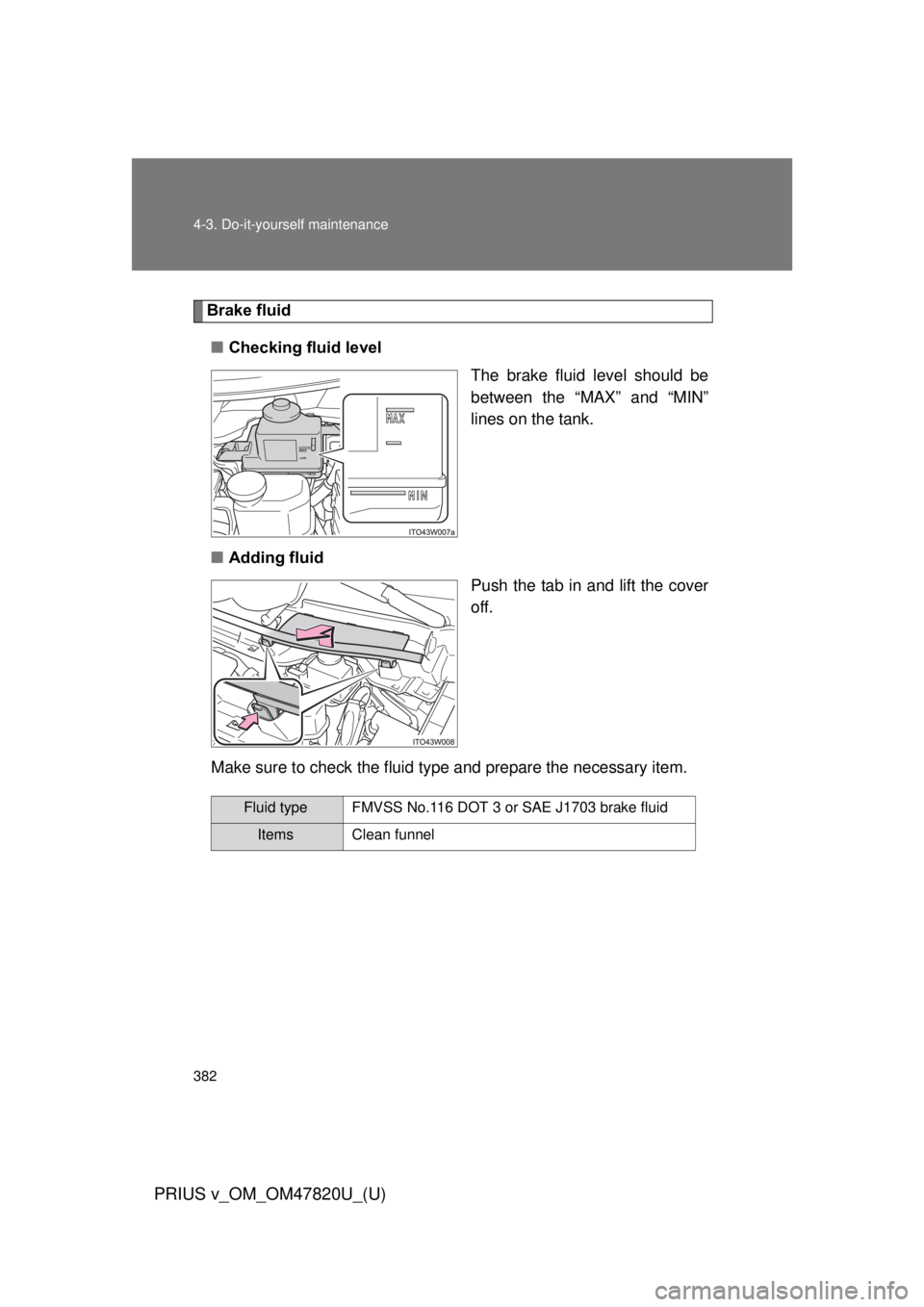
382 4-3. Do-it-yourself maintenance
PRIUS v_OM_OM47820U_(U)
Brake fluid■ Checking fluid level
The brake fluid level should be
between the “MAX” and “MIN”
lines on the tank.
■ Adding fluid
Push the tab in and lift the cover
off.
Make sure to check the fluid type and prepare the necessary item.
Fluid type FMVSS No.116 DOT 3 or SAE J1703 brake fluid
Items Clean funnel
Page 383 of 568

383
4-3. Do-it-yourself maintenance
PRIUS v_OM_OM47820U_(U)
4
Maintenance and care
■
Brake fluid can absorb moisture from the air
Excess moisture in the brake fluid can cause a dangerous loss of braking
efficiency. Use only newly opened brake fluid.
CAUTION
■When filling the reservoir
Take care as brake fluid can harm your hands and eyes and damage painted
surfaces.
If fluid gets on your hands or in your eyes, flush the affected area with clean
water immediately.
If you still experience discomfort, see a doctor.
NOTICE
■If the fluid level is low or high
It is normal for the brake fluid level to go down slightly as the brake pads
wear out or when the fluid level in the accumulator is high.
If the reservoir needs frequent refilling, there may be a serious proble\
m.
Page 384 of 568
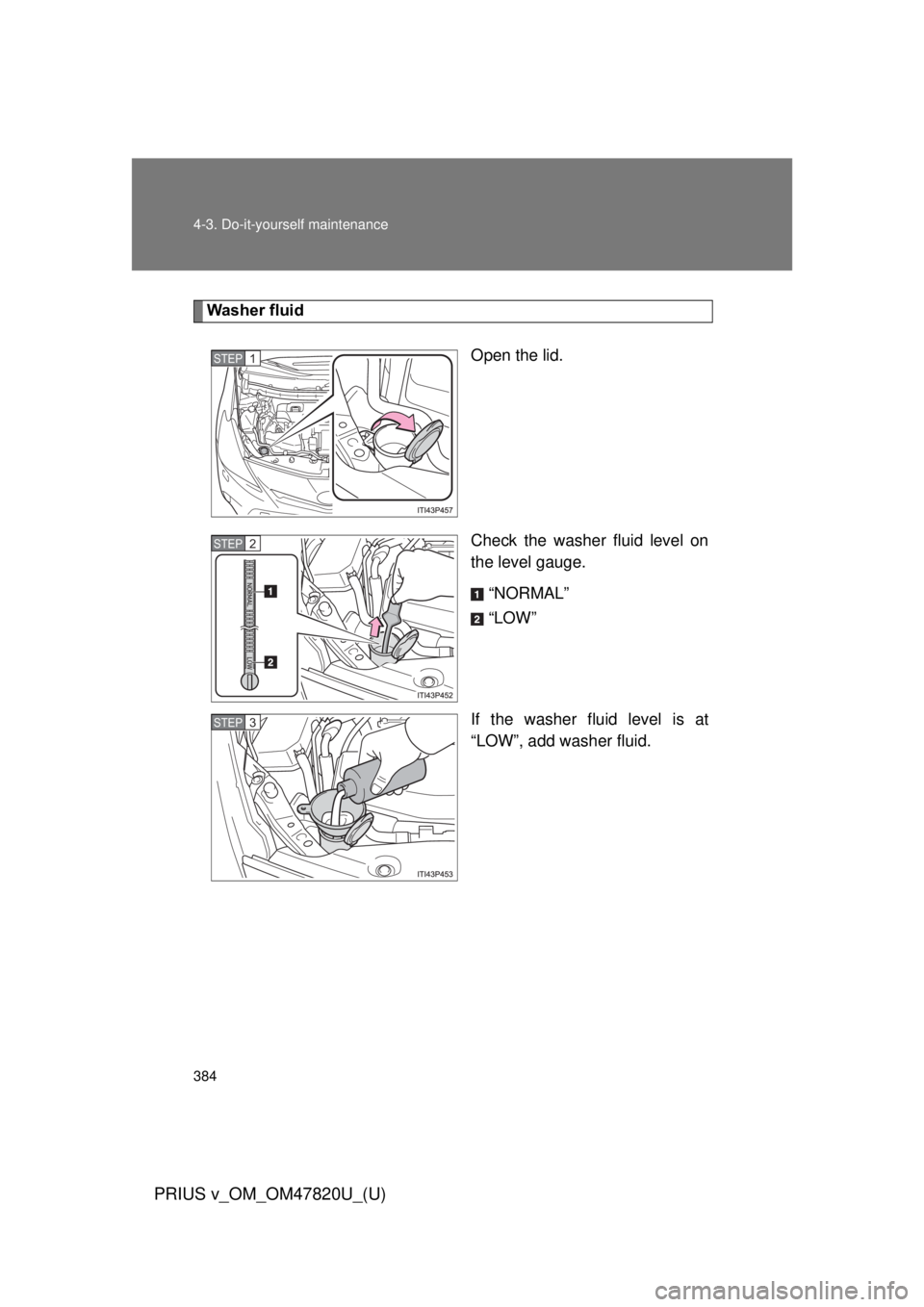
384 4-3. Do-it-yourself maintenance
PRIUS v_OM_OM47820U_(U)
Washer fluidOpen the lid.
Check the washer fluid level on
the level gauge.“NORMAL”
“LOW”
If the washer fluid level is at
“LOW”, add washer fluid.
STEP 1
STEP 2
STEP 3
Page 385 of 568
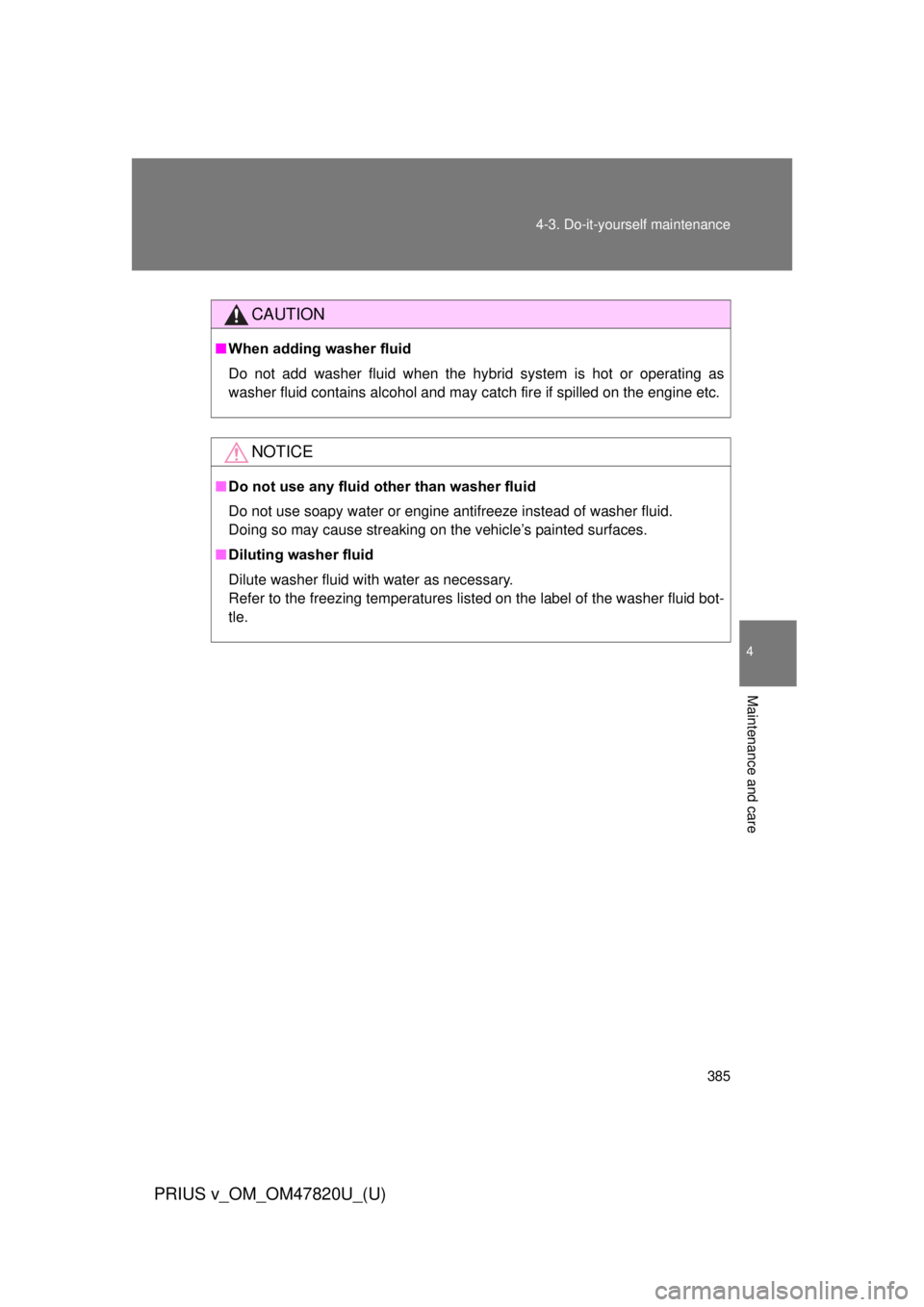
385
4-3. Do-it-yourself maintenance
PRIUS v_OM_OM47820U_(U)
4
Maintenance and care
CAUTION
■
When adding washer fluid
Do not add washer fluid when the hybrid system is hot or operating as
washer fluid contains alcohol and may catch fire if spilled on the engine etc.
NOTICE
■Do not use any fluid other than washer fluid
Do not use soapy water or engine antifreeze instead of washer fluid.
Doing so may cause streaking on the vehicle’s painted surfaces.
■ Diluting washer fluid
Dilute washer fluid with water as necessary.
Refer to the freezing temperatures listed on the label of the washer fluid bot-
tle.
Page 386 of 568

386
4-3. Do-it-yourself maintenance
PRIUS v_OM_OM47820U_(U)
12-volt batter y
■Location
The 12-volt battery is located
in the right-hand side of lug-
gage compartment.
■ Removing the 12-volt battery cover
Open the center deck board and remove the right side deck
board. ( P. 329)
Remove the center auxiliary box. ( P. 465)
Remove the right side auxil-
iary box.
STEP 1
STEP 2
STEP 3
Page 387 of 568

387
4-3. Do-it-yourself maintenance
PRIUS v_OM_OM47820U_(U)
4
Maintenance and care
■
Before recharging
When recharging, the 12-volt battery produces hydrogen gas which is flam-
mable and explosive. Therefore, observe the following precautions before
recharging:
● If recharging with the 12-volt battery installed on the vehicle, be sure to
disconnect the ground cable.
● Make sure the power switch on the charger is off when connecting and
disconnecting the charger cables to the 12-volt battery.
■ Exterior
Make sure that the 12-volt battery terminals are not corroded
and that there are no loose c onnections, cracks, or loose
clamps.
Terminals
Hold-down clamp
Page 388 of 568
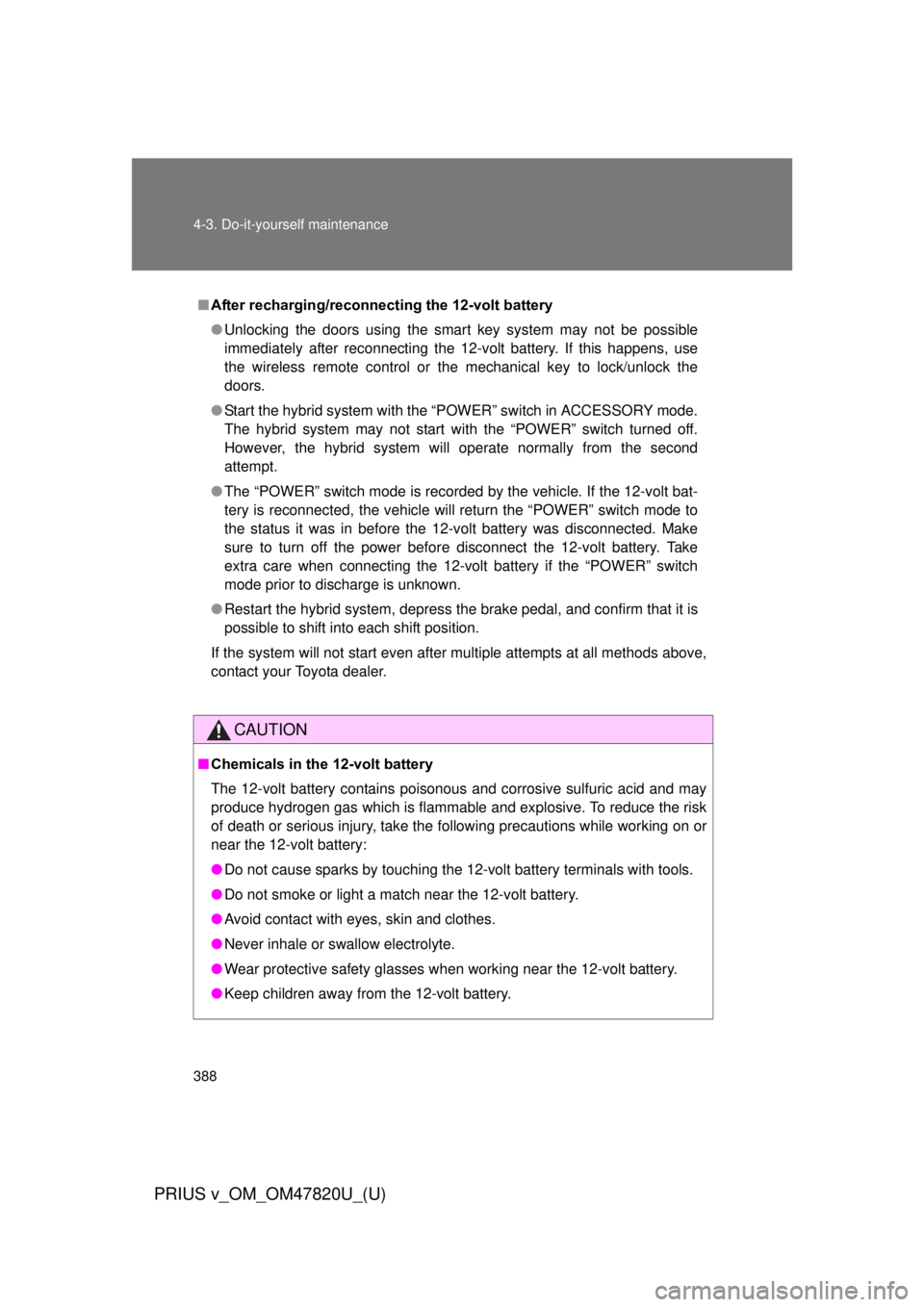
388 4-3. Do-it-yourself maintenance
PRIUS v_OM_OM47820U_(U)
■After recharging/reconnecting the 12-volt battery
● Unlocking the doors using the smart key system may not be possible
immediately after reconnecting the 12-volt battery. If this happens, use
the wireless remote control or the mechanical key to lock/unlock the
doors.
● Start the hybrid system with the “POWER” switch in ACCESSORY mode.
The hybrid system may not start with the “POWER” switch turned off.
However, the hybrid system will operate normally from the second
attempt.
● The “POWER” switch mode is recorded by the vehicle. If the 12-volt bat-
tery is reconnected, the vehicle will return the “POWER” switch mode to
the status it was in before the 12-volt battery was disconnected. Make
sure to turn off the power before disconnect the 12-volt battery. Take
extra care when connecting the 12-volt battery if the “POWER” switch
mode prior to discharge is unknown.
● Restart the hybrid system, depress the brake pedal, and confirm that it is
possible to shift into each shift position.
If the system will not start even after multiple attempts at all methods above,
contact your Toyota dealer.
CAUTION
■ Chemicals in the 12-volt battery
The 12-volt battery contains poisonous and corrosive sulfuric acid and may
produce hydrogen gas which is flammable and explosive. To reduce the risk
of death or serious injury, take the following precautions while working on or
near the 12-volt battery:
● Do not cause sparks by touching the 12-volt battery terminals with tools.
● Do not smoke or light a match near the 12-volt battery.
● Avoid contact with eyes, skin and clothes.
● Never inhale or swallow electrolyte.
● Wear protective safety glasses when working near the 12-volt battery.
● Keep children away from the 12-volt battery.
Page 389 of 568
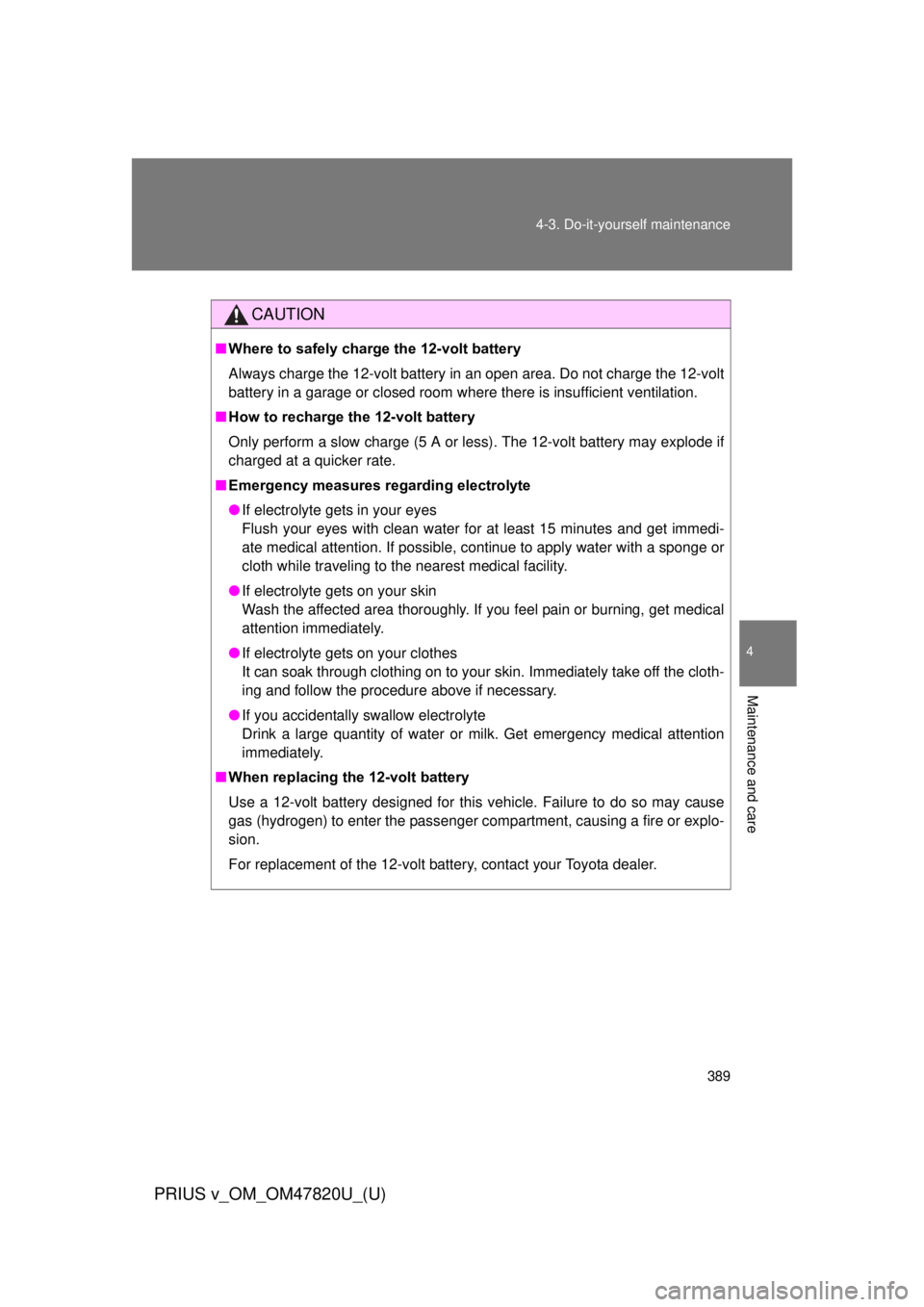
389
4-3. Do-it-yourself maintenance
PRIUS v_OM_OM47820U_(U)
4
Maintenance and care
CAUTION
■
Where to safely charge the 12-volt battery
Always charge the 12-volt battery in an open area. Do not charge the 12-volt
battery in a garage or closed room where there is insufficient ventilation.
■ How to recharge the 12-volt battery
Only perform a slow charge (5 A or less). The 12-volt battery may explode if
charged at a quicker rate.
■ Emergency measures regarding electrolyte
● If electrolyte gets in your eyes
Flush your eyes with clean water for at least 15 minutes and get immedi-
ate medical attention. If possible, continue to apply water with a sponge or
cloth while traveling to the nearest medical facility.
● If electrolyte gets on your skin
Wash the affected area thoroughly. If you feel pain or burning, get medical
attention immediately.
● If electrolyte gets on your clothes
It can soak through clothing on to your skin. Immediately take off the cloth-
ing and follow the procedure above if necessary.
● If you accidentally swallow electrolyte
Drink a large quantity of water or milk. Get emergency medical attention
immediately.
■ When replacing the 12-volt battery
Use a 12-volt battery designed for this vehicle. Failure to do so may ca\
use
gas (hydrogen) to enter the passenger co mpartment, causing a fire or explo-
sion.
For replacement of the 12-volt battery, contact your Toyota dealer.
Page 390 of 568
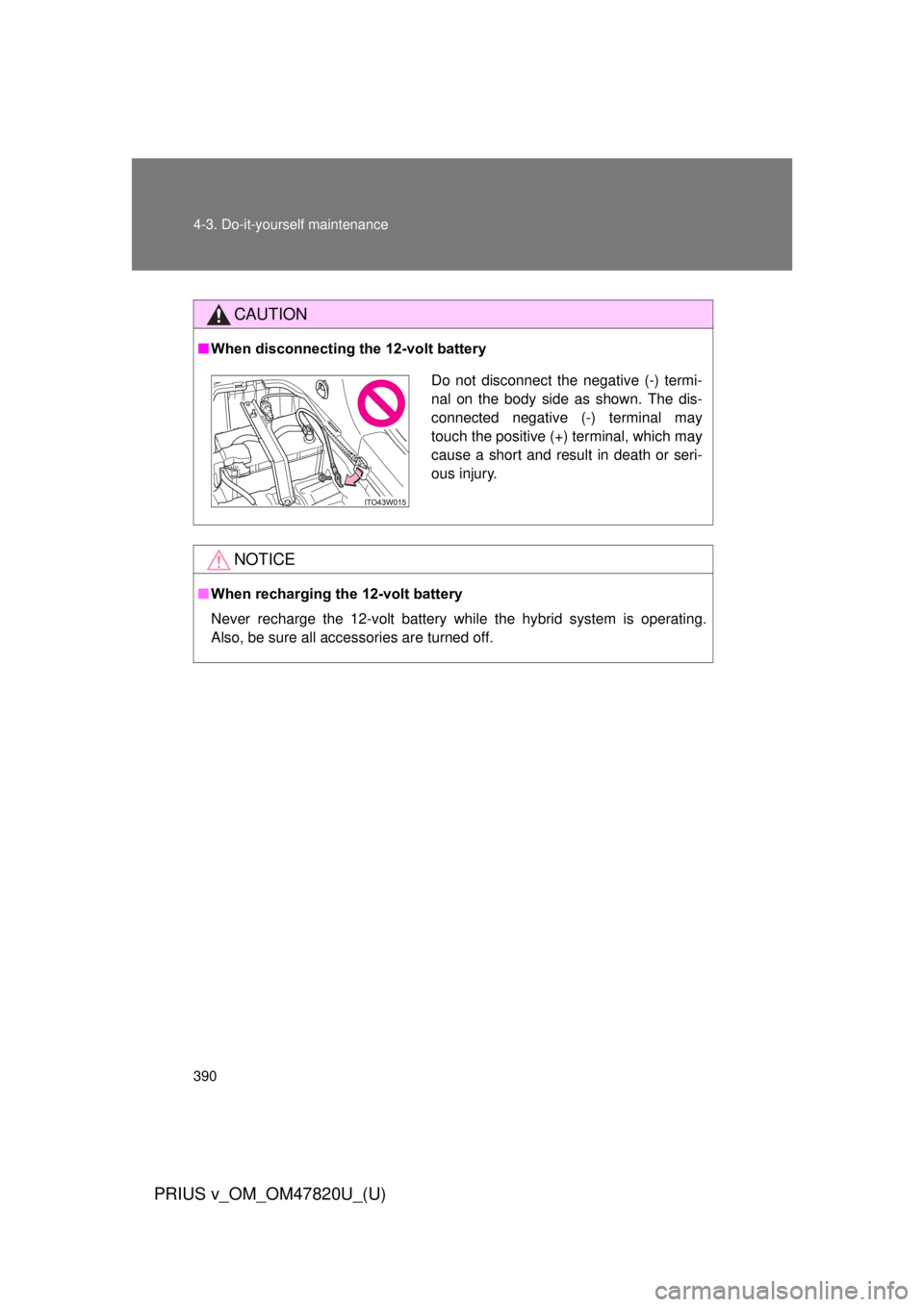
390 4-3. Do-it-yourself maintenance
PRIUS v_OM_OM47820U_(U)
CAUTION
■When disconnecting the 12-volt battery
NOTICE
■When recharging the 12-volt battery
Never recharge the 12-volt battery while the hybrid system is operating.
Also, be sure all accessories are turned off.
Do not disconnect the negative (-) termi-
nal on the body side as shown. The dis-
connected negative (-) terminal may
touch the positive (+) terminal, which may
cause a short and result in death or seri-
ous injury.